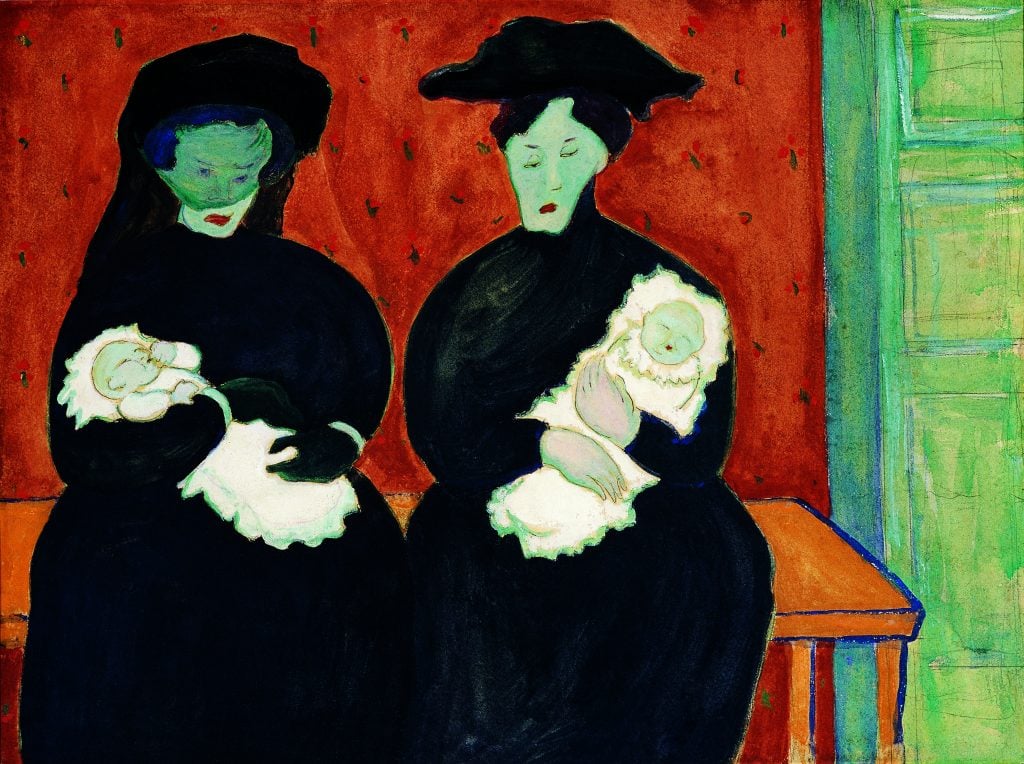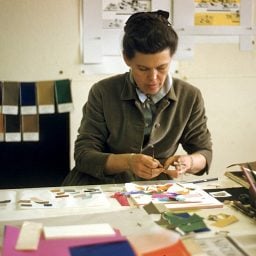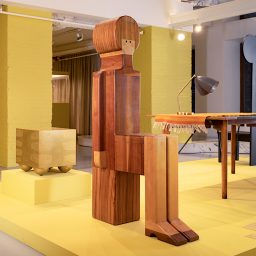There’s some wild painting on show in London in Making Modernism. The Royal Academy’s new exhibition of women artists working in Germany in the early 20th century offers a fresh perspective on some of the great Modernist subjects—nightlife, the nude, the self. The work is burningly experimental—I spent ages hovering in close, trying to work out how paint had been applied—and distinctive in viewpoint.
Gabriele Münter portrays small children as complex beings full of thoughts and feelings. One grasps himself anxiously, another cocks her head, full of attitude. Paula Modersohn-Becker’s retort to the supine nudes of art history is to paint herself standing upright, naked but for a straw hat trailing orange ribbons—a color picked up in the fruit she holds, and the assertive triangle of her pubic hair. In Gabriele Werefkin’s The Dancer Alexander Sacharoff (1909), the gender-fluid performer emerges from fields of ascending blue, his skin, pale as a duck egg, illuminated by coral red burning from his eyes, lips and cheeks. Käthe Kollwitz translates studies of her own body writhing in sexual frenzy into a series of etchings showing skeletal death wrestling a grieving mother for the body of her child.
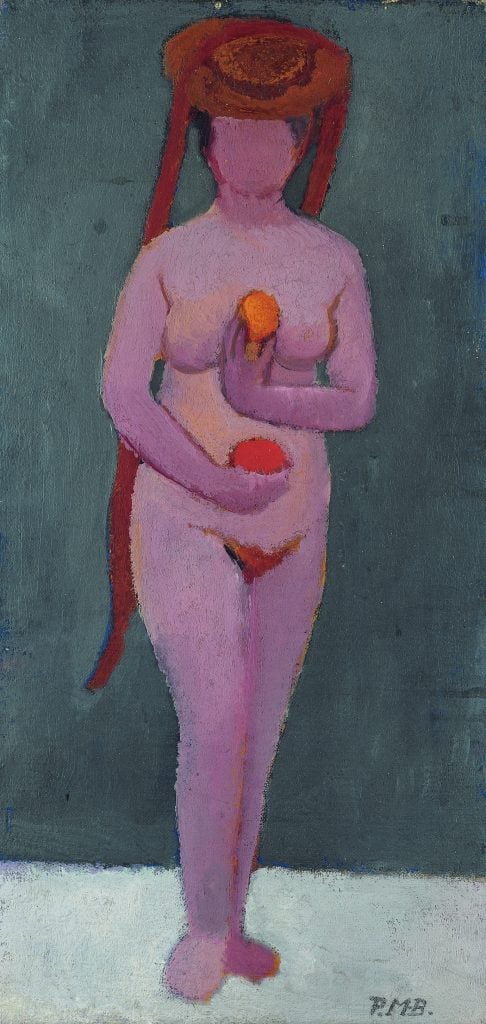
Paula Modersohn-Becker, Self-portrait as a Standing Nude with Hat (1906). Image courtesy Paula Modersohn-Becker Stiftung, Bremen.
Making Modernism is the work of British curator Dorothy Price, who has researched, written about, and taught German Modernism for, she admits “all of [my] adult life, basically.” Some 30 years ago, during her postgraduate research into the art and images of 1920s Berlin, Price realized that there was “a huge gap between how art history is constructed and taught in UK academia, and the existence of a whole world of women.” Even her own PhD thesis presented “a one-sided view of modernism—it [didn’t] take account of female subjectivity at all.” So she went back and started to explore the lives and art of the women working in Germany at the time. Recently appointed Professor of Modern and Contemporary Art and Visual Culture at London’s Courtauld Institute, Price’s scholarship has introduced British art history students to the work of important women artists, most notably Paula Modersohn-Becker.
With the exception of Käthe Kollwitz, the artists in Making Modernism have been little, if ever, shown in Britain. And as Price admits, the exhibition only “scratches the surface” of the subject. “It would be great if this prompts other institutions in this country to do monographic shows.”
In the opening gallery, Price positions her artists within a dynamic creative milieu, demonstrating how deeply involved they were in conversations around color, spirituality, psychoanalysis, and modern society. In one interior study, Gabriele Münter shows her partner Wassily Kandinsky peeping over the bedcovers in an adjacent room. In another, he is seated at the kitchen table in his slippers, deep in conversation with the artist Erma Bossi. Münter also paints Paul Klee in a deep blue armchair, his head positioned as though an artifact in the collection of Folk Art arranged on a shelf behind him.
As with the Barbican’s (unfortunately overloaded) 2018 exhibition Modern Couples, Making Modernism not only moves away from the idea of the avant-garde as a boys’ club, it also reminds us that ideas seldom emerge in isolation. Münter and Kandinsky weren’t just sharing a bed: they painted side by side, argued, conversed, and hung out with artist friends.
How important were these women to developments in the art of this period? “From my perspective—from things I’ve read, and from their own words, none of it could really have happened without the women in the circle,” explains Price. The influence was material, as well as intellectual. “Münter financed Kandinsky, Marianne Werefkin financed [Alexej Von] Jawlensky. So [the avant-garde group] Der Blaue Reiter would not have been the same without Münter and Werefkin at all.”
Living in twinned apartments with Jawlensky in Munich, Werefkin held artists’ salons where “ideas were discussed and fermented,” says Price. “The idea of the Phalanx and Neue Künstlervereinigung [art groups] and all those avant-garde moments are born in the salon.”
Werefkin, meanwhile, was recording her own ideas about art in an epistolary diary, published after her death in 1938 as Lettres à un Inconnu (Letters to a Stranger). “She talks a lot in terms of the spirituality of color,” notes Price. “This was in the early 1900s, prior to Kandinsky publishing Concerning the Spiritual in Art (1912), where he obviously talks a lot about spirituality and color. The kernel of those ideas are already being written in Werefkin’s diaries. She records having conversations with Kandinsky and him dismissing her ideas a little bit, so there’s interesting gender politics around those diaries as well.”

Marianne Werefkin, Circus – Before the Show (1908/10). Image courtesy of Leopold-Hoesch-Museum, Düren. Photo: © Peter Hinschlaeger
In addressing female subjectivity, Price was keen to include works that suggested female sexual desire “because we don’t often see that in Modernism—we see a lot of male sexual desire.” Pondering the ways in which male desire manifests itself in art of the time, the treatment of girlhood in this exhibition is particularly striking.
Ottilie Reylaender’s Beta Naked (ca.1900) portrays a chilly-looking 12-year-old dwarfed by the high-backed chair she’s perched on. Tense and a little cross, her pale limbs poke out of the darkness of a wintery interior. As Price points out, Reylaender was a teenager herself at the time—just 17 or 18: “There’s not a massive difference in age, probably five years or so between model and the artist. So there’s a different kind of relationship between artist and model. It’s a girl on the cusp of adulthood—Ottilie—painting a girl on the cusp of pubescence. A really interesting dynamic.”
Throughout the show, girlhood is addressed without sentimentality or prurience. Werefkin’s Portrait of a Girl (1913) is towering—eyes closed, she seems caught in private thought. In Modersohn-Becker’s Seated Nude Girl, Her Legs Pulled Up (ca.1904), the artist paints her stepdaughter Elsbeth looking cold and a little bored. The artist wrote of the awkwardness she felt in paying local children to model for her when living in the artists’ colony in rural Worpswede. “In all representations of the nude there’s a power relationship,” notes Price. “I think what’s interesting about the ones that I’m showing is that it’s not a sexualized power relationship in the same way as, say, Gauguin or Munch. But it is a power relationship nevertheless. And it’s a class one.”
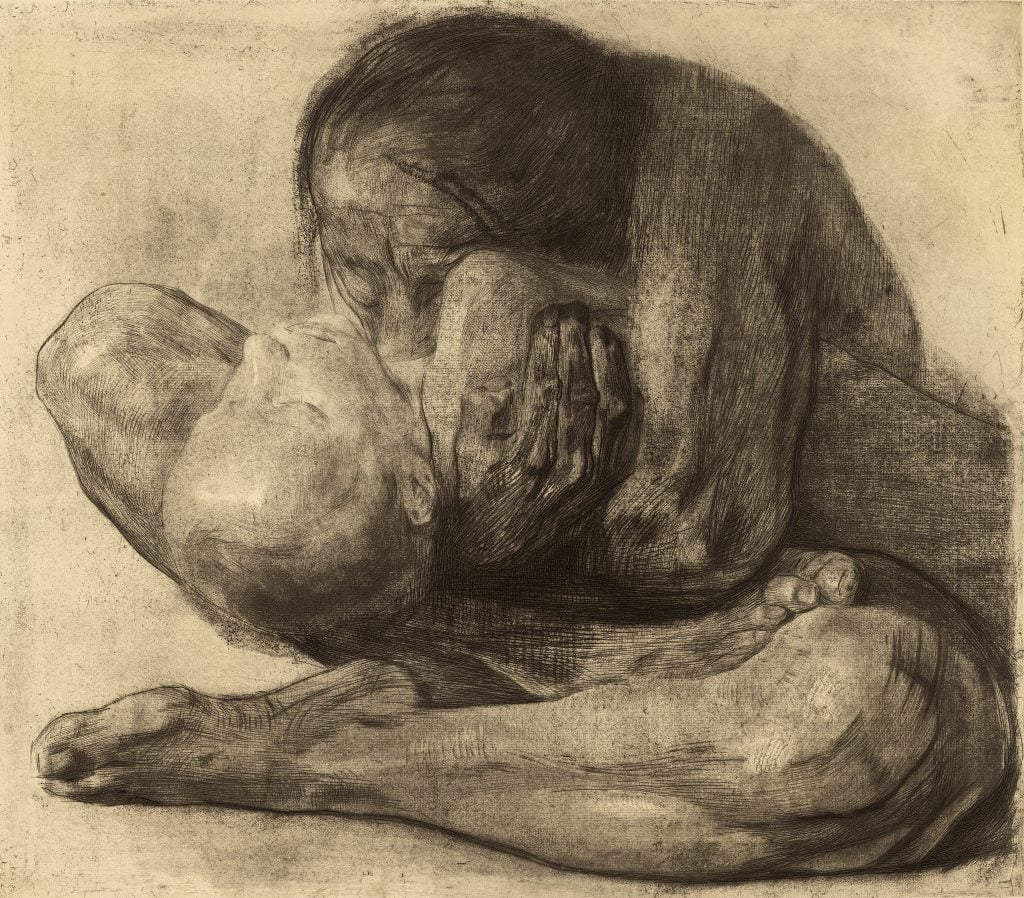
Käthe Kollwitz, Woman with Dead Child (1903). © Käthe Kollwitz Museum Köln
No one at this point would argue the importance of shining a light on overlooked women artists. Taking the position of devil’s advocate, I ask Price what these women actually bring to the story of Modernism? She directs my attention to the central room in the show, which explores intimacy. On one side are Kollwitz’s powerfully claustrophobic studies of maternal love and grief, and her own experience of illicit sexual pleasure. On the other, Modersohn-Becker brings the mannered poise of Renaissance saints into her treatment of solid flesh-and-blood women, complete with dirty fingernails and ruddy faces. The nude is re-imagined as a maternal figure.
“We’re seeing the female perspective on Modernity,” says Price, simply. “I wanted to think about what the themes of modernism are, typically, and how they then are recalibrated if we look at them through the eyes of women artists.”
Making Modernism: Paula Modersohn-Becker, Käthe Kollwitz, Gabriele Münter and Marianne Werefkin, Royal Academy of Arts, London, 12 November 2022–12 February 2023
More Trending Stories:
In a ‘Once-in-a-Lifetime’ Discovery, Swedish Archaeologists Have Unearthed a Cache of Viking Silver That Still Looks Brand New
Sarah Biffin, the Celebrated Victorian Miniaturist Born Without Hands, Is Now Receiving Her First Major Show in 100 Years
Disgraced Antiques Dealer Subhash Kapoor Handed a 10-Year Jail Sentence by an Indian Court
It Took Eight Years, an Army of Engineers, and 1,600 Pounds of Chains to Bring Artist Charles Gaines’s Profound Meditation on America to Life. Now, It’s Here
‘I’ll Have Terrific Shows Posthumously,’ Hedda Sterne Said. She Was Right—and Now the Late Artist Is Getting the Recognition She Deserved
Click Here to See Our Latest Artnet Auctions, Live Now
